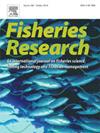Allocating catches to species in mixed species data – A model-based approach
IF 2.2
2区 农林科学
Q2 FISHERIES
引用次数: 0
Abstract
Stock assessments should ideally be conducted at the species level, but this can be difficult when commercial catches are reported by species group rather than by species. This is a common problem if species are hard to identify or it is too time consuming to do so. Species split algorithms are applied in such cases. We outline a GAM-based approach for splitting species-aggregated catch and effort data to species and apply them to two species groups (tiger and endeavour prawns) in Australia’s Northern Prawn Fishery. The best models incorporate spatial, temporal and biophysical covariates, demonstrating strong explanatory power and robust performance in cross-validation tests. The results suggest that the annual split to species by location and day of the year is constant over time for the endeavour prawns. However, evidence exists for long-term trends (i.e., non-stationary) when splitting the tiger prawns. This highlights the importance of regularly updating this information.
求助全文
约1分钟内获得全文
求助全文
来源期刊

Fisheries Research
农林科学-渔业
CiteScore
4.50
自引率
16.70%
发文量
294
审稿时长
15 weeks
期刊介绍:
This journal provides an international forum for the publication of papers in the areas of fisheries science, fishing technology, fisheries management and relevant socio-economics. The scope covers fisheries in salt, brackish and freshwater systems, and all aspects of associated ecology, environmental aspects of fisheries, and economics. Both theoretical and practical papers are acceptable, including laboratory and field experimental studies relevant to fisheries. Papers on the conservation of exploitable living resources are welcome. Review and Viewpoint articles are also published. As the specified areas inevitably impinge on and interrelate with each other, the approach of the journal is multidisciplinary, and authors are encouraged to emphasise the relevance of their own work to that of other disciplines. The journal is intended for fisheries scientists, biological oceanographers, gear technologists, economists, managers, administrators, policy makers and legislators.
 求助内容:
求助内容: 应助结果提醒方式:
应助结果提醒方式:


